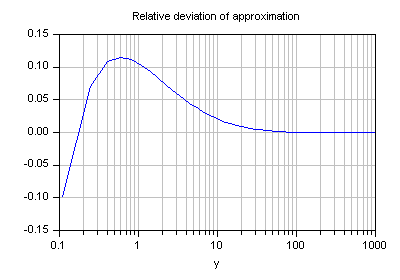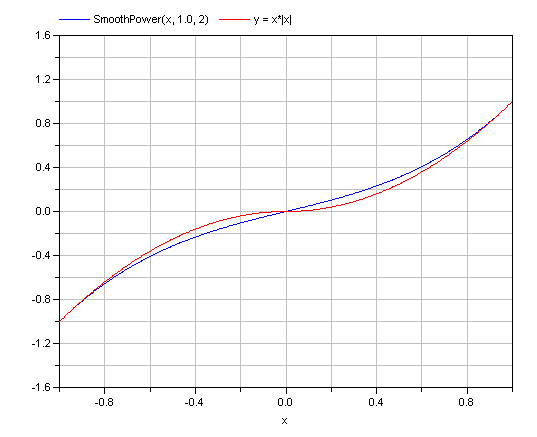Package with utility functions
Extends from Modelica.Icons.FunctionsPackage (Icon for packages containing functions).
| Name | Description |
|---|---|
| Cubic Hermite spline interpolation of the Reynolds number in transition regime of the Moody diagram (inverse formulation) | |
| Cubic Hermite spline interpolation of the modified friction coefficient in transition regime of the Moody diagram (direct formulation) | |
| Closed approximation of Lambert's w function for solving f(x) = x exp(x) for x | |
| Iterative form of Lambert's w function for solving f(x) = x exp(x) for x | |
| Calculation of Prandtl number | |
| Calculation of Reynolds number | |
| Limiting the derivative of function y = if x>=0 then x^pow else -(-x)^pow | |
| The derivative of function SmoothPower | |
| Continuous interpolation for x | |
| Derivative of function Stepsmoother |
 Modelica.Fluid.Dissipation.Utilities.Functions.General.CubicInterpolation_Re
Modelica.Fluid.Dissipation.Utilities.Functions.General.CubicInterpolation_ReCubic Hermite spline interpolation of the Reynolds number in transition regime of the Moody diagram (inverse formulation)
Re = CubicInterpolation_Re(0, Re1, Re2, Delta, lambda2);
Function CubicInterpolation_Re(..) approximates the Reynolds number
Re in the transition regime between laminar and turbulent flow
of the Moody diagram by an inverse formulation of a cubic Hermite spline interpolation. See
Modelica.Fluid.UsersGuide.ComponentDefinition.WallFriction (especially Region 2)
for a detailed explanation.
Extends from Modelica.Icons.Function (Icon for functions).
| Name | Description |
|---|---|
| Re_turbulent | Unused input |
| Re1 | Boundary Reynolds number for laminar regime [1] |
| Re2 | Boundary Reynolds number for turbulent regime [1] |
| Delta | Relative roughness |
| lambda2 | Modified friction coefficient (= independent variable) |
| Name | Description |
|---|---|
| Re | Interpolated Reynolds number in transition region [1] |
 Modelica.Fluid.Dissipation.Utilities.Functions.General.CubicInterpolation_lambda
Modelica.Fluid.Dissipation.Utilities.Functions.General.CubicInterpolation_lambdaCubic Hermite spline interpolation of the modified friction coefficient in transition regime of the Moody diagram (direct formulation)
lambda2 = CubicInterpolation_lambda(Re, Re1, Re2, Delta);
Function CubicInterpolation_lambda(..) approximates the modified friction coefficient
lambda2=lambda*Re^2 in the transition regime between laminar and turbulent flow
of the Moody diagram by a (direct) cubic Hermite spline interpolation.
See
Modelica.Fluid.UsersGuide.ComponentDefinition.WallFriction (especially Region 2)
for a detailed explanation.
Extends from Modelica.Icons.Function (Icon for functions).
| Name | Description |
|---|---|
| Re | Reynolds number (= independent variable) [1] |
| Re1 | Boundary Reynolds number for laminar regime [1] |
| Re2 | Boundary Reynolds number for turbulent regime [1] |
| Delta | Relative roughness |
| Name | Description |
|---|---|
| lambda2 | Interpolated modified friction coefficient in transition regime |
 Modelica.Fluid.Dissipation.Utilities.Functions.General.LambertW
Modelica.Fluid.Dissipation.Utilities.Functions.General.LambertWClosed approximation of Lambert's w function for solving f(x) = x exp(x) for x
This function calculates an approximation of the inverse for
f(x) = y = x * exp( x )
within ∞ > y > -1/e. The relative deviation of this approximation for Lambert's w function x = W(y) is displayed in the following graph.

For y > 10 and higher values the relative deviation is smaller 2%.
Extends from Modelica.Icons.Function (Icon for functions).
| Name | Description |
|---|---|
| y | Input f(x) |
| Name | Description |
|---|---|
| x | Output W(y) |
 Modelica.Fluid.Dissipation.Utilities.Functions.General.LambertWIter
Modelica.Fluid.Dissipation.Utilities.Functions.General.LambertWIterIterative form of Lambert's w function for solving f(x) = x exp(x) for x
This function calculates an approximation of the inverse for
f(x) = y = x * exp( x )
within ∞ > y > -1/e. Please note, that for negative inputs two solutions exists. The function currently delivers the result x = -1 ... 0 for that particular range.
Extends from Modelica.Icons.Function (Icon for functions).
| Name | Description |
|---|---|
| y | Input f(x) |
| Name | Description |
|---|---|
| x | Output W(y) |
| iter |
 Modelica.Fluid.Dissipation.Utilities.Functions.General.PrandtlNumber
Modelica.Fluid.Dissipation.Utilities.Functions.General.PrandtlNumberCalculation of Prandtl number
Extends from Modelica.Icons.Function (Icon for functions).
| Name | Description |
|---|---|
| cp | Specific heat capacity of fluid at constant pressure [J/(kg.K)] |
| eta | Dynamic viscosity of fluid [Pa.s] |
| lambda | Thermal conductivity of fluid [W/(m.K)] |
| Name | Description |
|---|---|
| Pr | Prandtl number [1] |
 Modelica.Fluid.Dissipation.Utilities.Functions.General.ReynoldsNumber
Modelica.Fluid.Dissipation.Utilities.Functions.General.ReynoldsNumberCalculation of Reynolds number
Extends from Modelica.Icons.Function (Icon for functions).
| Name | Description |
|---|---|
| A_cross | Cross sectional area [m2] |
| perimeter | Wetted perimeter [m] |
| rho | Density of fluid [kg/m3] |
| eta | Dynamic viscosity of fluid [Pa.s] |
| m_flow | Mass flow rate [kg/s] |
| Name | Description |
|---|---|
| Re | Reynolds number [1] |
| velocity | Mean velocity [m/s] |
 Modelica.Fluid.Dissipation.Utilities.Functions.General.SmoothPower
Modelica.Fluid.Dissipation.Utilities.Functions.General.SmoothPowerLimiting the derivative of function y = if x>=0 then x^pow else -(-x)^pow
The function is used to limit the derivative of the following function at x=0:
y = if x ≥ 0 then xpow else -(-x)pow; // pow > 0
by approximating the function in the range -deltax< x < deltax with a third order polynomial that has the same derivative at abs(x)=deltax, as the function above.
In the picture below the input x is increased from -1 to 1. The range of interpolation is defined by the same range. Displayed is the output of the function SmoothPower compared to
y=x*|x|
For |x| > 1 both functions return identical results.

Extends from Modelica.Icons.Function (Icon for functions).
| Name | Description |
|---|---|
| x | Input variable |
| deltax | Range for interpolation |
| pow | Exponent for x |
| Name | Description |
|---|---|
| y | Output variable |
 Modelica.Fluid.Dissipation.Utilities.Functions.General.SmoothPower_der
Modelica.Fluid.Dissipation.Utilities.Functions.General.SmoothPower_derThe derivative of function SmoothPower
Extends from Modelica.Icons.Function (Icon for functions).
| Name | Description |
|---|---|
| x | Input variable |
| deltax | Range of interpolation |
| pow | Exponent for x |
| dx | Derivative of x |
| Name | Description |
|---|---|
| dy | Derivative of SmoothPower |
 Modelica.Fluid.Dissipation.Utilities.Functions.General.Stepsmoother
Modelica.Fluid.Dissipation.Utilities.Functions.General.StepsmootherContinuous interpolation for x
The function is used for continuous fading of variable inputs within a defined range. It allows a differentiable and smooth transition between function outputs, e.g., laminar and turbulent pressure drop or correlations for certain ranges.
The tanh-function is used, since it provides an existing derivative and the derivative is zero at the borders [nofunc, func] of the interpolation domain (smooth derivative for transitions).
In order to work correctly, the internal interpolation range in terms of the external arbitrary input x needs to be scaled such that:
f(func) = 0.5 π f(nofunc) = -0.5 π
In the picture below the input x is increased from 0 to 1. The range of interpolation is defined by:

Extends from Modelica.Icons.Function (Icon for functions).
| Name | Description |
|---|---|
| func | Input value for that result = 100% |
| nofunc | Input value for that result = 0% |
| x | Input variable for continuous interpolation |
| Name | Description |
|---|---|
| result | Output value |
 Modelica.Fluid.Dissipation.Utilities.Functions.General.Stepsmoother_der
Modelica.Fluid.Dissipation.Utilities.Functions.General.Stepsmoother_derDerivative of function Stepsmoother
Extends from Modelica.Icons.Function (Icon for functions).
| Name | Description |
|---|---|
| func | Input for that result = 100% |
| nofunc | Input for that result = 0% |
| x | Input for interpolation |
| dfunc | Derivative of func |
| dnofunc | Derivative of nofunc |
| dx | Derivative of x |
| Name | Description |
|---|---|
| dresult |